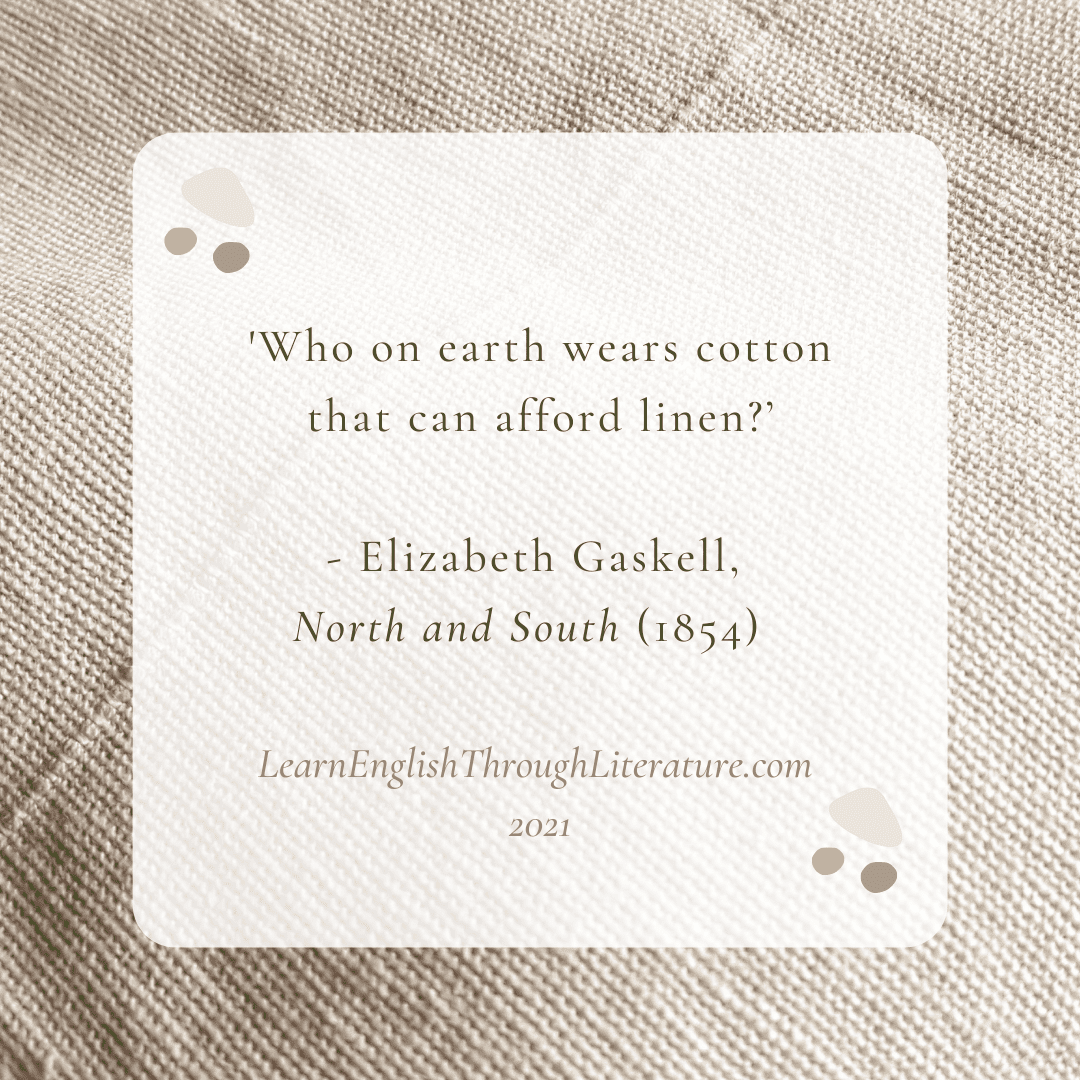This wonderful novel by Elizabeth Gaskell is set in mid-19th century (c. 1850s) England, where the main character, a strong-minded girl called Margaret Hale, is forced together with her family to leave their lovely home in the sunny south of England and move to a smoky, industrial town further north (‘Milton’ – a fictional name for Manchester). There she meets with people who are from a different social background to herself, and she becomes deeply interested in the plights (difficult or unfortunate situations and experiences) of the poor and what she can do to help. Meanwhile, she battles with her family’s expectations of her (they want her to associate with wealthier people and adopt their ways) and her own preference for what is simple and unaffected (sincere, without pretence).
✍️ For this reason, I have decided to write a Lesson that includes a new vocabulary list as well as some descriptions of British social norms connected with dress codes and types of textiles or fabrics (at least at the time the novel was written in 1854 – although some still apply today).
👉 Before we begin, I would like to list some general vocabulary relating to dress and textiles (types of cloth or fabric) to add to the eight specialist terms that Gaskell’s novel offers – eight words describing different types of fabric and their social importance. As there is quite a lot to write about each of these eight terms, I have divided this Lesson into two parts and include some illustrations to help you identify them for yourself whenever you see them.
One last note: Some of the quotations from Gaskell’s North and South may have some advanced words that you don’t understand. Don’t worry: the point of today’s particular Lesson is to learn about the highlighted vocabulary and believe me, there is quite a lot to learn just from those words! So we will not treat these passages from Gaskell as a strict ‘reading comprehension’ exercise. I encourage you to read through it all, but not to get stuck on trying to fully understand everything! (In fact, there are a few North and South series that you can watch to get an idea of the novel as well – I will link to one that I enjoyed here. You will definitely appreciate it more after learning about the different types of textiles in the story and their significance / meaning!) 😊
…
📝 SOME USEFUL VOCABULARY CONNECTED WITH DRESS AND TEXTILES:
braid: This is a thin strip of three twisted cloth or threads that are used as a decoration (sometimes attached to uniforms, etc. as a decoration)
drapery: Cloth that is either hanging (like curtains) or arranged in folds
fibre: The thread-like parts of a plant or artificial material that can be made into fabric.
fluff: Light and soft pieces of soft material (like wool or fur) that are often detached from their source (for example: ‘That pillow has a hole in it: some of its fluff is floating around’ or ‘She had cat fluff all over her clothes after holding the kitten’).
netting: Decorative or strongly made material in the form of a net
padding: Pieces of material that are used either to protect something (e.g., ‘those books I bought online were packaged with a lot of padding’) or to give it shape (e.g., ‘the pillow has a lot of padding inside to give it that shape’)
thread: a piece of very thin rope made of intertwined fibres, usually used for sewing.
wear: (VERB) 1. to carry clothing or jewellery on your body. 2. to have a specific expression on your face. 3. to become weaker, more damaged because of constant use. (NOUN) 1. clothes that are either of a particular type or suited for a specific use (e.g., swimwear, knitwear, formal wear, etc.). 2. The act of wearing something or of something being worn. 3. Something’s wearing quality and durability. 4. The result of wearing or using (certain clothes) and / or their deterioration over time (e.g., ‘a wear-resistant strap’)
weave: to twist long threads together repeatedly in a criss-cross way (sometimes using a special frame) to make cloth
yarn: [American English] thread that is used for making cloth or for knitting garments (clothes)
…
Now that we have defined those general textile words, here are more eight more specific textile-related words that you should know, together with some examples drawn from Elizabeth Gaskell’s North and South.
📝 #1 MUSLIN
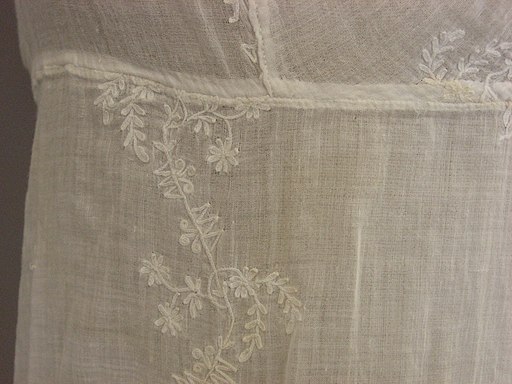
Image Credit: Auckland Museum, CC BY 4.0, via Wikimedia Commons
muslin: cotton fabric with various degrees of lightness and fineness. It can be woven, embroidered, or even printed with decorative patterns. As a plain-woven cloth, it is used for sheets and for draining cheese in cheese-making processes.
This cloth was so versatile that it was often used for pretty yet simple dresses. Edith Shaw wears it for a bridal party her mother is hosting in their home, so it is neither too simple nor too luxurious, but light and bright.
📙 ‘Edith had fallen asleep. She lay curled up on the sofa in the back drawing-room in Harley Street, looking very lovely in her white muslin and blue ribbons.’
– Elizabeth Gaskell, North and South
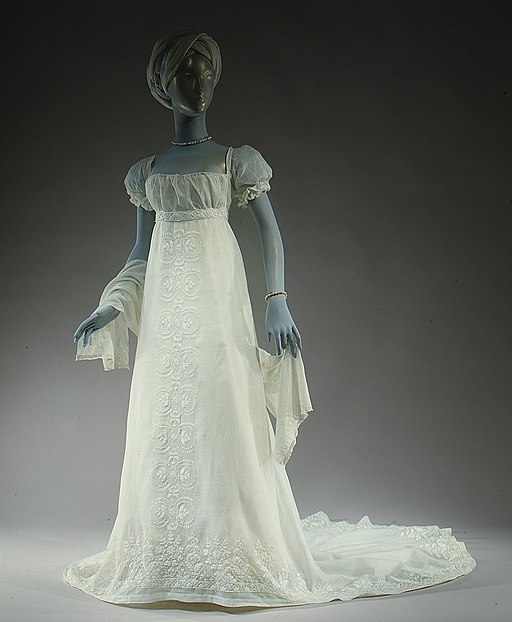
Image Credit: Metropolitan Museum of Art, CC0, via Wikimedia Commons
📙 ‘… in spite of the buzz in the next room, Edith had rolled herself up into a soft ball of muslin and ribbon, and silken curls, and gone off into a peaceful little after-dinner nap.’
– Elizabeth Gaskell, North and South
Muslin is sometimes used to make curtains or even small cloth bags that hold flower petals (pot pourri) or foods like cheese.
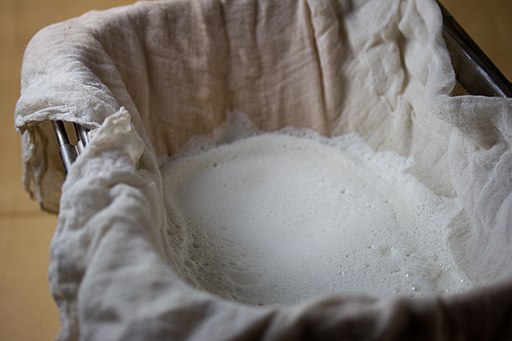
Image Credit: Veganbaking.net from USA, CC BY-SA 2.0, via Wikimedia Commons
In this next quotation, Mrs Hale is complaining about how the smoky atmosphere of Milton is making her white curtains dirty:
📙 “I only know it is impossible to keep the muslin blinds clean here above a week together; and at Helstone we have had them up for a month or more, and they have not looked dirty at the end of that time.”
– Elizabeth Gaskell, North and South
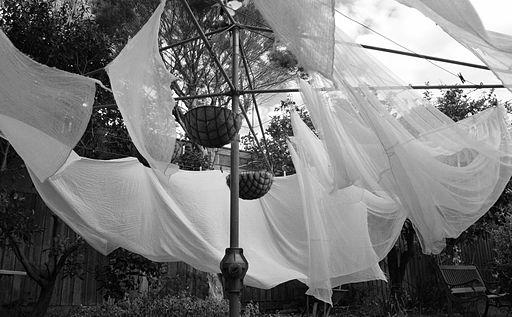
Image Credit: Dahliyani Briedis, CC BY 3.0, via Wikimedia Commons
Another novel that includes several references to muslin is Jane Austen’s Northanger Abbey, in which the protagonist Catherine Morland wears a ‘sprigged muslin’ dress to her first ball. ‘Sprigged’ simply meant that the muslin had a pattern of little sprigs 🌱 (small twigs with flowers or leaves) printed on the white muslin. Henry Tilney famously remarks that he ‘[does] not think it will wash well’.
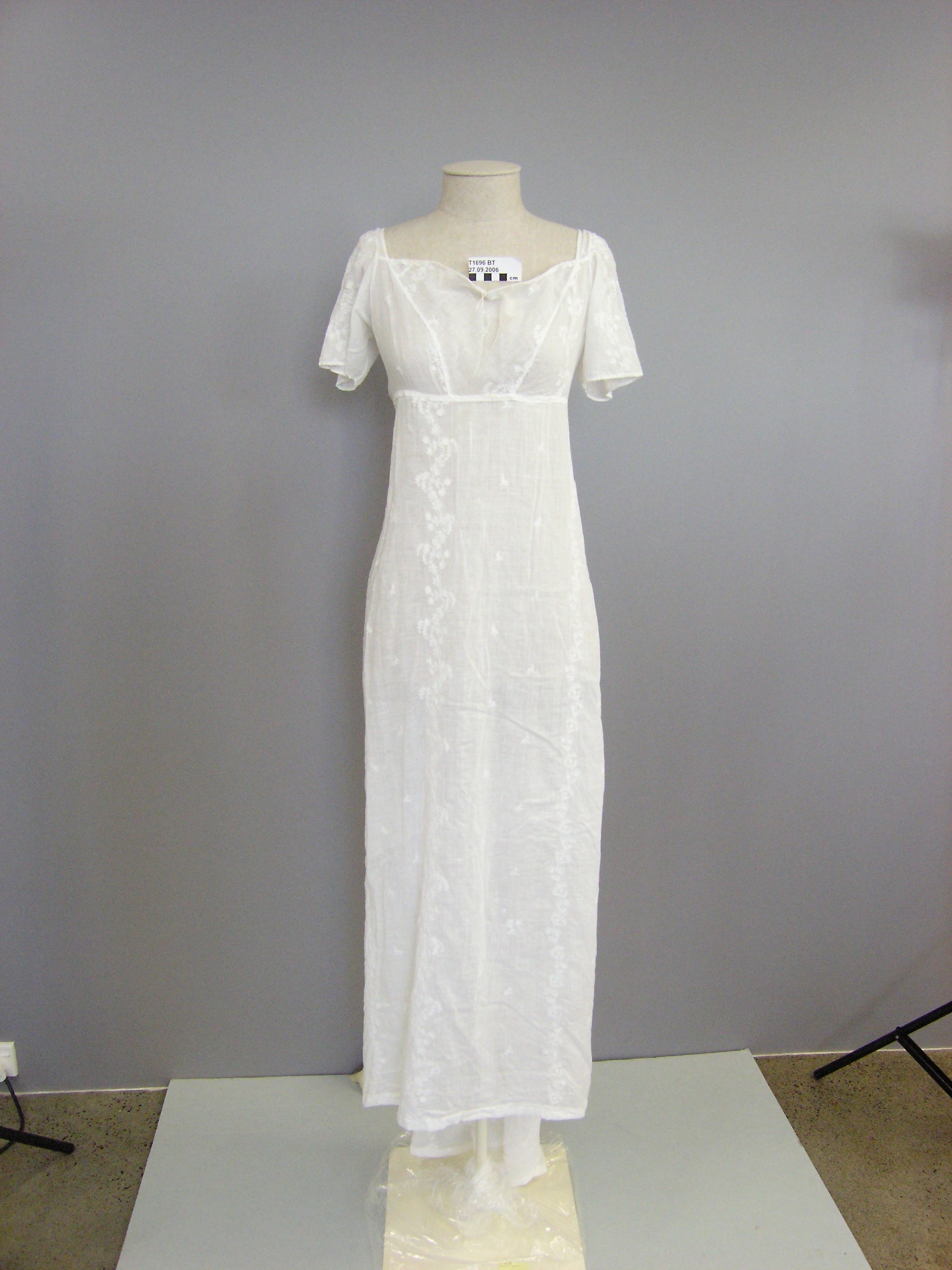
Image Credit: By Auckland Museum, CC BY 4.0, via Wikimedia Commons
…
📝 #2 COTTON
cotton: This is one of the most widely-known and widely-found types of fabric anywhere in the world, even though the plant from which the fibres are harvested can only be found in a few warm-climate countries.
It is a strong and organic material, hardier and thicker than muslin but lighter and softer than calico. It was also fairly cheap to buy and use in tailoring (making clothes).

Image Credit: Melissa Manning, Pixabay
In mid-19th century England, around the time that North and South (1854) is set, Manchester and other towns in England’s ‘industrial north’ prospered as cotton-manufacturing towns with many factories.
In many such factories, the ‘fluff’ or cotton bolls were spun into thread with which to make large sheets of the cloth through special machines. This was difficult and dangerous work, as the small fibrous dust from the cotton was always circulating (moving in circles) in the air and could cause lung problems if breathed in too deeply, as poor Bessy describes in a quotation further along.
Here is a comment that Margaret’s mother makes, saying that if a person can afford better quality clothing (for example, linen) they will not wear cotton like the factory people do.
📙 ” … but these factory people, who on earth wears cotton that can afford linen?”
– Elizabeth Gaskell, North and South
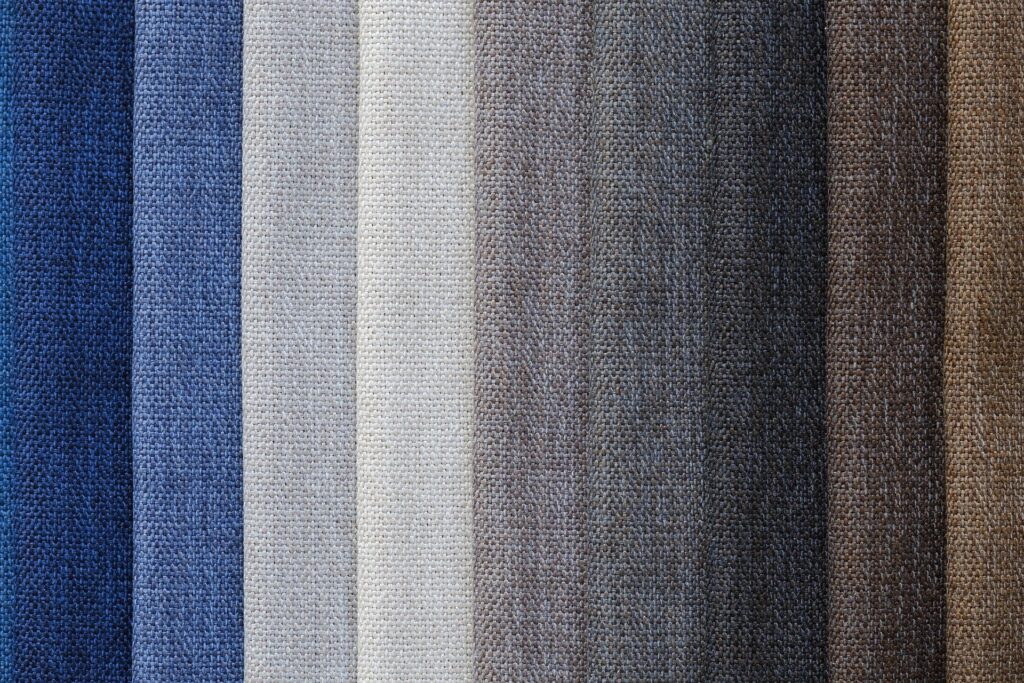
Image Credit: Bruno/Germany from Pixabay

Image Credit: Monfocus from Pixabay
📙 “Fluff,” repeated Bessy. “Little bits, as fly off fro’ the cotton, when they’re carding it, and fill the air till it looks all [like] fine white dust.”
– Elizabeth Gaskell, North and South
📙 “The whole machinery — I don’t mean the wood and iron machinery now — of the cotton trade is so new that it is no wonder if it does not work well in every part all at once.”
– Elizabeth Gaskell, North and South
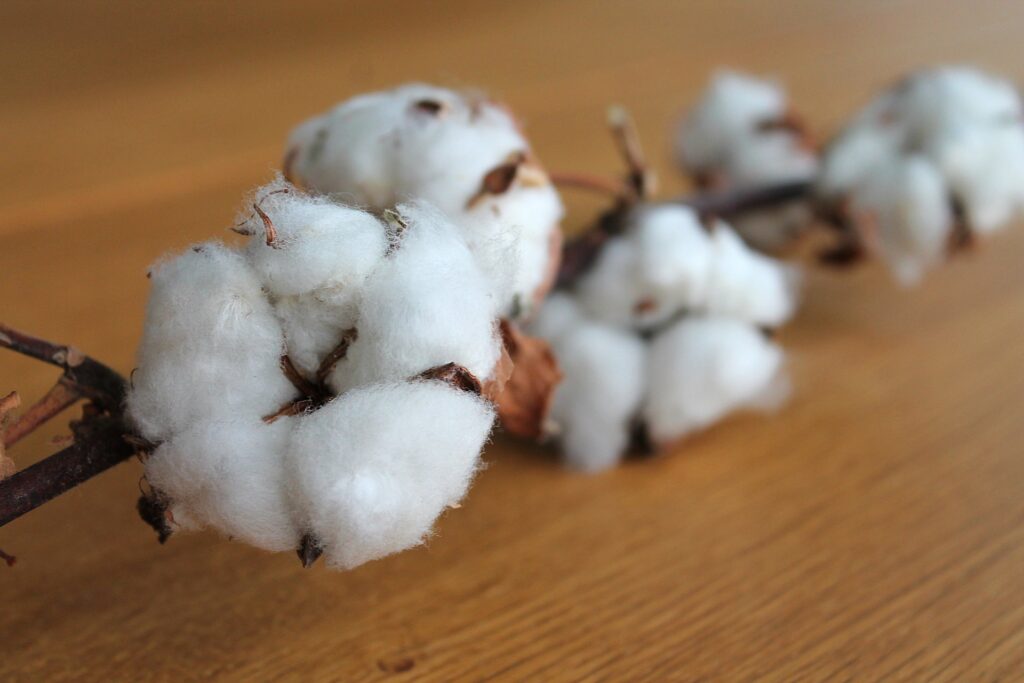
Image Credit: Tove Erbs, from Pixabay
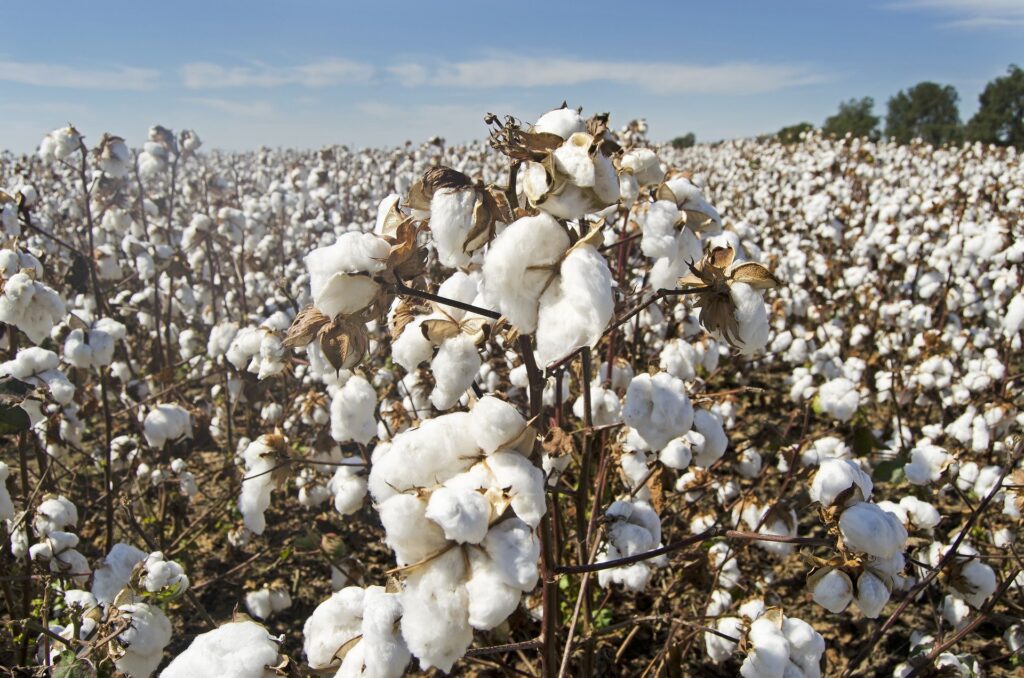
Image Credit: Jim Black, from Pixabay
…
📝 #3 CALICO
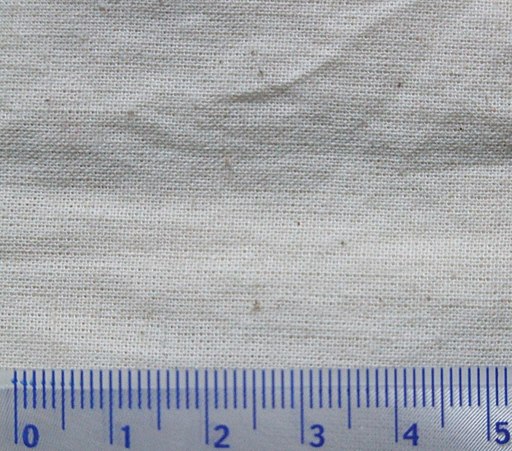
Image Credit: Clem Rutter, Rochester, Kent., CC BY-SA 3.0, via Wikimedia Commons
Calico: This is a plain-woven cloth made from unbleached and not fully processed cotton. Sometimes the husks (the dry outer covering of some fruit or seeds) of the cotton plant can even be found woven into the cloth itself. The fabric is also more coarse and thicker than muslin, hence it is the cheapest cloth (of natural materials) available and was popularly used to make dresses for poorer people.
📙 ‘But there the heavy lumbering vehicles seemed various in their purposes and intent; here every van, every waggon and truck, bore cotton, either in the raw shape in bags, or the woven shape in bales of calico. People thronged the footpaths, most of them well-dressed as regarded the material, but with a slovenly looseness which struck Margaret as different from the shabby, threadbare smartness of a similar class in London.’
– Elizabeth Gaskell, North and South
📙 “Why, I may give you, as an instance, an advertisement, inserted not fifty years ago in a Milton paper, that so-and-so (one of the half-dozen calico-printers of the time) would close his warehouse at noon each day; therefore, that all purchasers must come before that hour.”
– Elizabeth Gaskell, North and South
📙 “Edith says she finds the printed calicoes in Corfu better and cheaper than in London.”
– Elizabeth Gaskell, North and South
If you have ever read Laura Ingalls Wilder’s wonderful biographical books – Little House on the Prairie – you will have read about Ma Ingalls making pretty, economical dresses for her daughters from calico.
…
📝 #4 LINEN
linen: This is a cloth woven from flax. ‘Linen’ also refers to materials – such as bed sheets – that are made from this type of cloth.
Linen is very strong and dries more quickly than cotton. It is also more prone to wrinkle.
Because it is more durable, it is also somewhat more costly than cotton and calico. This is why Margaret’s mother, who is always wanting to associate with the more well off (richer, affluent, prosperous), criticises the poorer ‘factory people’ that Margaret wants to get to know because they only wear cotton – if they could afford linen instead, it would show that they had better means (were better off economically, had a good income to afford linen, were richer, etc.).
📙 “… but these factory people, who on earth wears cotton that can afford linen?”
– Elizabeth Gaskell, North and South
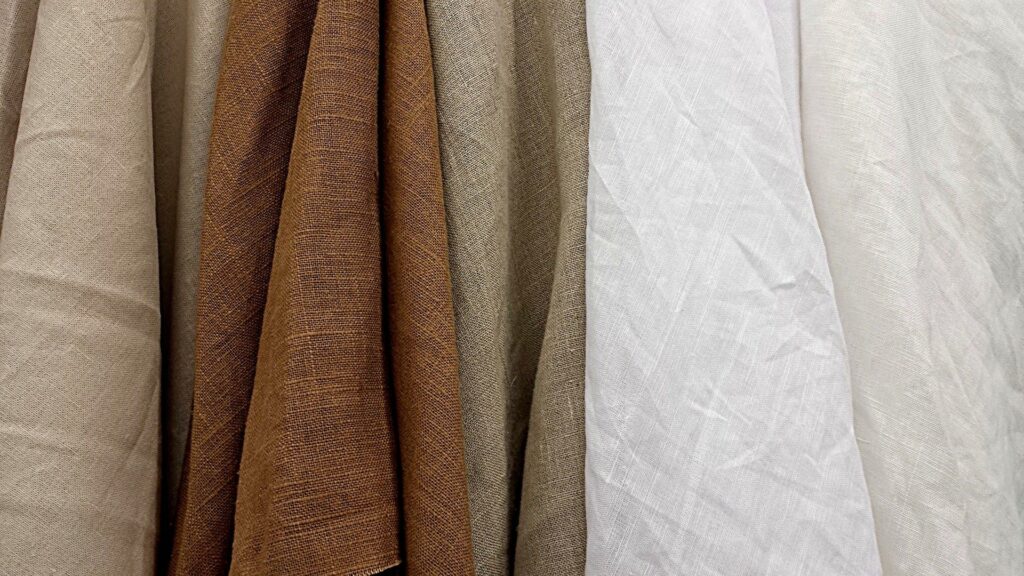
Image Credit: DWilliam, from Pixabay
As mentioned in the definition above, linen can also denote (indicates; is shown to be a sign of) bed and table linen sheets, indeed any household item made from linen cloth (such as napkins or doilies).
Elizabeth Gaskell writes about how Mrs Thornton becomes excited as her son gets ready to propose marriage. She begins to count all her special household linen, expecting that she will give these to the next ‘Mrs Thornton’ – her new daughter-in-law.
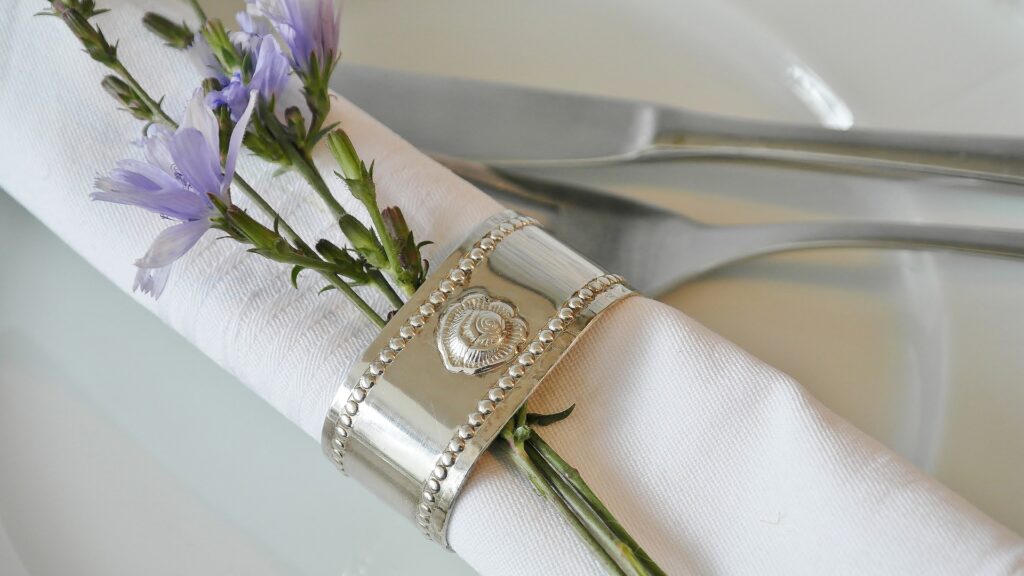
Image Credit: RitaE, from Pixabay
📙 ‘The newly-married couple-to-be would need fresh household stocks of linen; and Mrs. Thornton had clothes-basket upon clothes-basket, full of table-cloths and napkins, brought in, and began to reckon up the store.’
– Elizabeth Gaskell, North and South
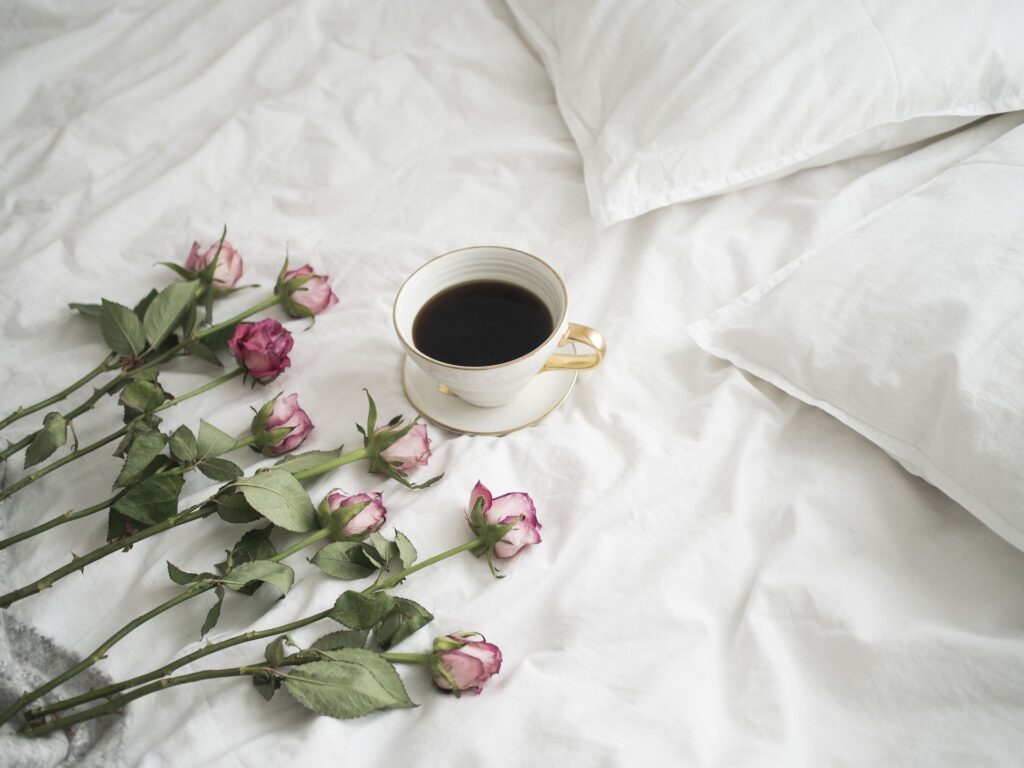
Image Credit: Monileoni, from Pixabay
📙 ‘She was to be John’s wife. To take Mrs. Thornton’s place as mistress of the house, was only one of the rich consequences which decked out the supreme glory; all household plenty and comfort, all purple and fine linen, honour, love, obedience, troops of friends, would all come as naturally as jewels on a king’s robe, and be as little thought of for their separate value.’
– Elizabeth Gaskell, North and South
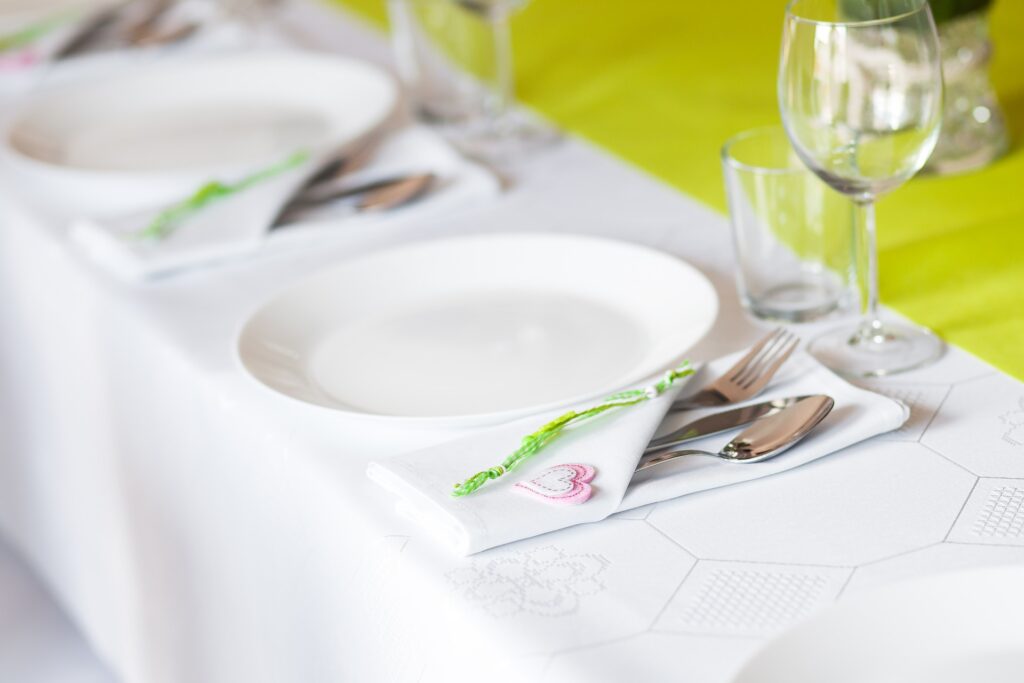
Image Credit: Maciej 05, from Pixabay
📙 ‘… she took up Henry’s Commentaries, and tried to fix her attention on it, instead of pursuing the employment she took pride and pleasure in, and continuing her inspection of the table-linen.’
– Elizabeth Gaskell, North and South
Linen is woven from a flowering plant called flax, which is often grown in Britain and Ireland for its fibres as well as its seeds (called flax seed or linseed).
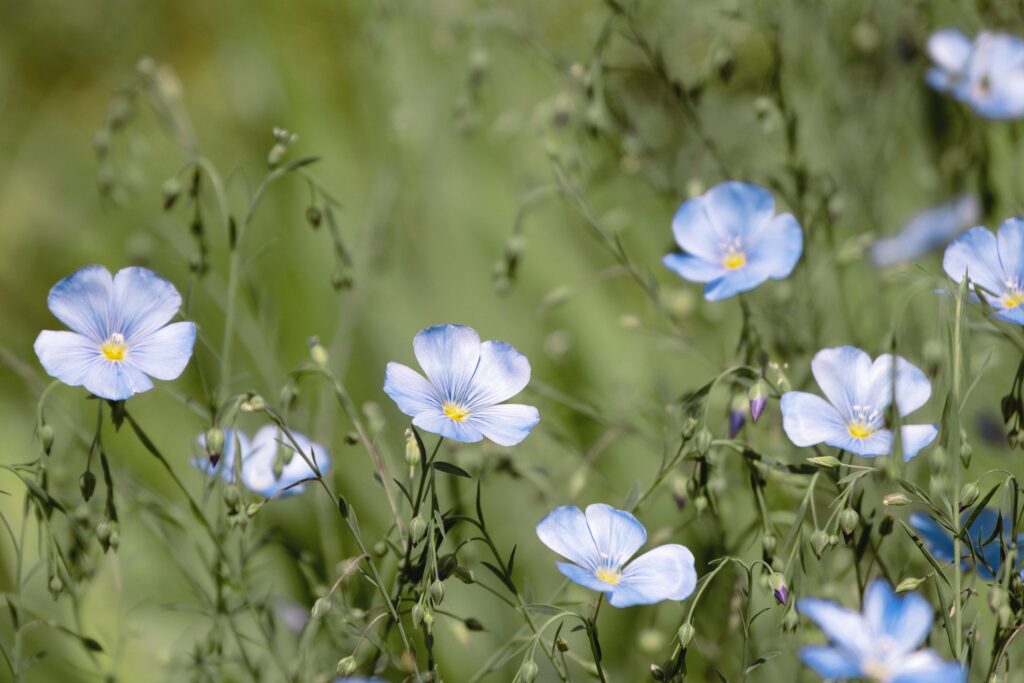
Image Credit: NickyPe, from Pixabay
In this next reference, the ‘white linen hung out’ to dry simply refers to large cloths of linen (probably bed sheets) that were hanging on a clothesline or even stretched out on hedges to dry in the sun.
📙 ‘A bleak back-ground of trees, some white linen hung out on the sweet-briar hedge, and a great waft of damp air.’
– Elizabeth Gaskell, North and South
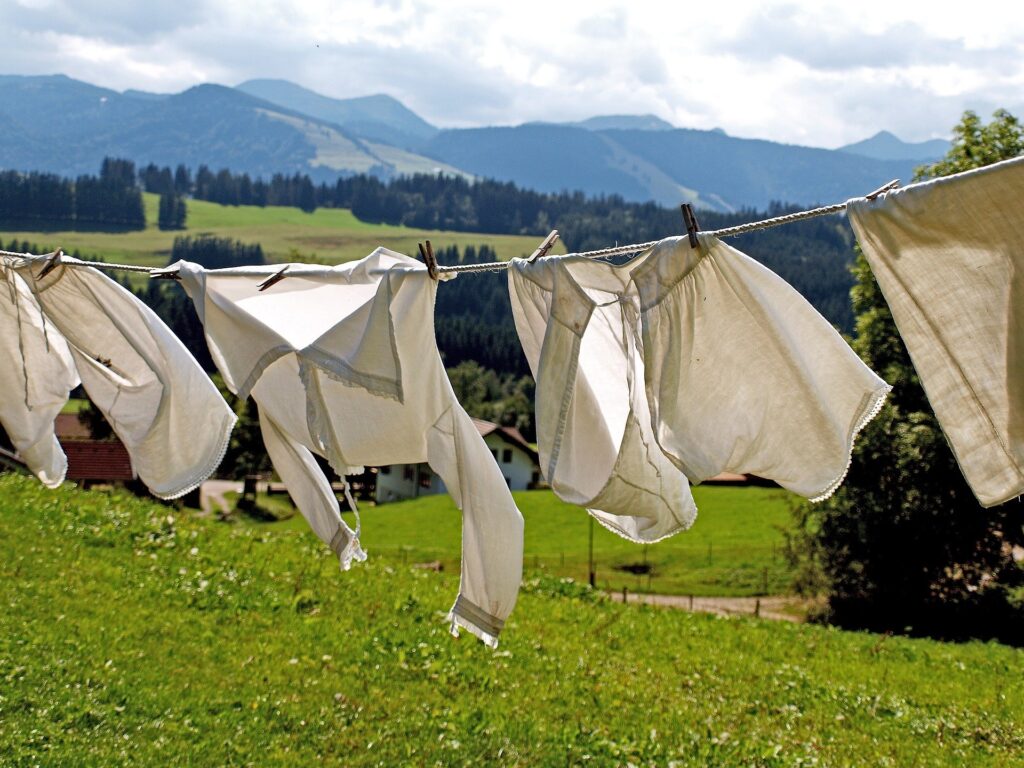
Image Credit: Willi Heidelbach, from Pixabay
Join me in Part 2 of this Lesson, where we will consider four more types of textiles that both feature in North and South and that are worth your time learning about! 👗🥼👕

